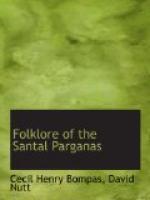So the villagers took up the dead body and carried it off to the Raja, taking Kora and the Dome with them. The Raja asked what proof there was as to who had killed the Rakhas: and first the Dome produced the leg which he had cut off; but Kora unrolled his cloth and showed the ears and tongue and claws of the Rakhas. It was at once seen that the leg which the Dome had brought wanted the claws, so his fraud was clearly proved and he was driven from the assembly with derision and had to go and humbly make his peace with the wife whom he had turned out of his house. But the nuptials of Kora and the Raja’s sister took place at once and they were given a fine palace to live in and a large tract of country for their own.
Kora never allowed himself to be separated from his faithful crab and this led to his life being saved a second time. A few nights after he was married, Kora was lying asleep with the crab upon his breast, when two snakes began to issue from the nostrils of his bride: their purpose was to kill Kora but when they saw the watchful crab they drew in their heads again. A few minutes later they again looked out: then the crab went and hid under the chin of the Princess and when the snakes put out their heads far enough it seized both of them with its claws: the snakes wriggled and struggled until they came entirely out of the nose of the princess and were dragged to the floor where the crab strangled them. In the morning Kora awoke and saw what the crab had done: he asked what he could do to show his gratitude to his faithful friend, and the crab asked to be set free in some pond which never dried up and that Kora would rescue it if any one ever succeeded in catching it. So Kora chose a tank and set the crab free and every day he used to go and bathe in that tank and the crab used to come and meet him.
After living in luxury for a time Kora went with a grand procession of horses and elephants to visit his industrious brothers who had turned him out of their home for laziness, and he showed them that he had chosen the better part, for they would never be able to keep horses and elephants for all their industry: so he invited them to come and live with him on his estate and when they had reaped that year’s crops they went with him.




